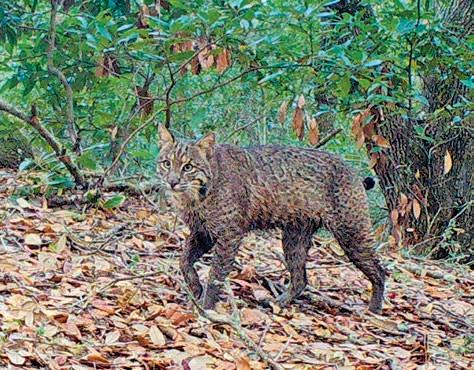
3 minute read
Wildlife Files: Bobcats
Last month, we did a feature that focused on our neighbors in nature throughout the Golden Isles. Yet there was one so stealthy that it slipped under our radar. Bobcats! Jekyll Island is home to a small population of bobcats. So sneaky!
A bobcat was first documented by photo on Jekyll Island in 2014. A year later, they identified a second bobcat. By 2016, there were two kittens. Because these cats are so elusive, it’s hard to pinpoint exactly how many there are. According to Joseph Colbert, a Certified Wildlife Biologist with the Jekyll Island Authority Conservation Department, we have the eagle eyes and diligence of some AmeriCorps Members to thank for the current estimate of 10-12 adult bobcats. Using photos captured of the cats on the many trail cameras they have situated around the island, they have been able to identify specific and unique patterns on each cat’s tail to differentiate between them. It’s like their fingerprint! By recording these different patterns for each cat, they can now tell if they’re seeing the same cats or new cats in the area.
Colbert shared that the first bobcat that they were able to monitor with a tracking device was a young male they named Bullwinkle (seen in photo on opposite page). He was found hiding in the foliage suffering from a case of what they were able to identify, with some assistance from the Jacksonville Zoo, as tick paralysis. Fortunately, treatment was simple: remove the ticks! They reached out to friends on Kiawah Island and we’re able to secure a tracking collar so they could monitor him following treatment. He appeared to be heading off the island the last time his collar transmitted and essentially vanished.
A recent report by Ben Carswell, JIA Director of Conservation and Sustainability, in the Jekyll Island Foundation Newsletter detailed more recent bobcat tracking efforts. “In 2019, with Jekyll Island Foundation support and
permitting approvals from Georgia DNR, the conservation team began working to capture and fit a GPS tracking collar on a Jekyll Island bobcat with the goal of enhancing the understanding of habitat use, movement patterns, and potential reproduction by these small but powerful predators.” They were unsuccessful in their attempts until 2020, when they were able to capture Victoria on the south end of the island, near the soccer complex. Carswell describes her as approximately one year old at time of capture, “in good health and, as a female just entering her reproductive years, an ideal subject for closer observation of her activity.” This February, just about the time her tracking collar was about to fail, Colbert says, “we got lucky and were able to capture her and replace the collar.” This enables them to continue monitoring her for about another year or so.
What has been learned from the Jekyll Island bobcats so far? Some interesting stuff! The primary food in the bobcats’ diet is rabbit. While they can be found anywhere on the island, there are some core areas where they tend to stay. (Victoria loves the golf course!). Bobcats are not social animals, so do not travel in groups, although a mother may be seen in a pair with a grown cub.
They are generally timid and will dart away if they see you. Most, importantly, they’ve been able to find a sustainable food source, have adapted to urban conditions, and are reproducing, so they are comfortable with Jekyll Island as a home range.
So, if you spot a bobcat, don’t be surprised. Their stealthy behavior and nocturnal movements make it rather unlikely that you will, but if you do, there’s no need to be alarmed or concerned. They’re not a threat to you. If you see an animal on Jekyll Island that appears injured or sick, please contact Wildlife Response at 912.222.5992. These cats aren’t bad neighbors to have around.
See What’s Trending in September!
Thompson Lydia Cheryl Keefer Rugaber Trish Ella Cart Dottie Clark Trish Rugaber Suzanne Clements Susan Anderson Joan Hilliard Linda Bobinger Lydia Thompson Cheryl Keefer
The Gallery with the Orange Door Open Tuesday - Saturday 10-4 and by appointment











